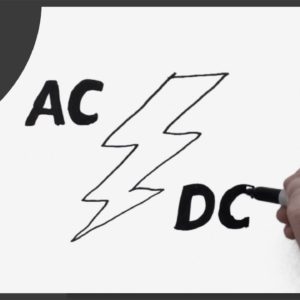If you're looking for a video on
legendary rock music you might have found the wrong channel. On a previous Add Ohms video we looked at Voltage, Power, and Current… …and you might remember this
animation. one problem with this animation is that the voltage source
shown was an AC source while the current flow was shown as DC So let's talk about
the difference between AC and DC. The letters DC stand for Direct Current and it generally means the electrons flow in a single direction. AC stands for alternating current and it means that the flow of electrons change. Now, this is where things can start to get a little confusing. This is an AC voltage source
so it's both AC and voltage.
How can voltage and current be the
same? Well it turns out we tend to use AC and DC abbreviations for voltage, as well as, current. So in other words AC voltage, or current, is voltage, or current,
that changes. DC voltage, or current, is voltage, or current, that is steady. Okay, so let's take a little bit closer
look at these two starting with DC Check out this AA, or LR6, battery. It provides 1.5 volts. This example circuit is going to
be a DC motor like you might find in a toy car. When we insert the battery into
the circuit, current begins to flow in a single direction, turning the motor. If we drew a graph, where the vertical axis is voltage and the horizontal axis is time, we can see that the voltage at this point stays constant.
Now, since this is a battery, eventually,
it's going to run out energy; and its output voltage will drop. So we know that the voltage will change over time, but the polarity will stay the same. So what is polarity? Well polarity defines the positive
direction and for a battery the positive voltage is created from the positive
terminal. So… what would happen if
we turn this battery around? Well, that reverses the polarity which means the current will flow in the
opposite direction as before, causing our motor to spin in the opposite direction. Okay, so let's move on to AC and in this case we're going to use a light bulb and a North-American AC socket, because well, I live in North America! Notice how the circuit behaves when we turn the switch on. Let's break down what we're seeing by using the voltage graph again. Notice how the current is flowing
in one direction and as voltage increases the light bulb gets brighter.
Once the voltage reaches its peak current flow stays the same but the
voltage begins to drop and the light bulb gets dimmer.

Once we reach zero volts,
the voltages polarity changes causing current to flow in the
opposite direction, and again as the voltage gets closer to its peak the bulb gets
brighter and then dims back down. Okay we needed to define a couple of things. First, is the change from start to finish is called a cycle. The rate at which the
cycle repeats is frequency. Now frequency is measured using the unit "Hertz,"
which means cycles per second. Different parts of the world use different frequencies for their AC systems and it can either be 50 or 60 Hertz. What this means is in one second
the cycle repeat itself at least 50 times. Believe it, or not, incandescent bulbs are actually
flashing over 50 times per second! Now it turns out, that this rate is so fast that our slow human eyes sees it as
constant light! In summary, while the abbreviations for AC and DC include the word "current,"
they can be used to describe different types of voltage and current. DC voltages do not fluctuate while
DC current flows in one direction AC voltages change over
time and the current flow can alternate direction.
If you have questions about this video please
feel free to leave comments below. For more electronics tutorials
*SUBSCRIBE* 🙂 to this channel. You can also find us on
Twitter and on the web @AddOhms.com.

